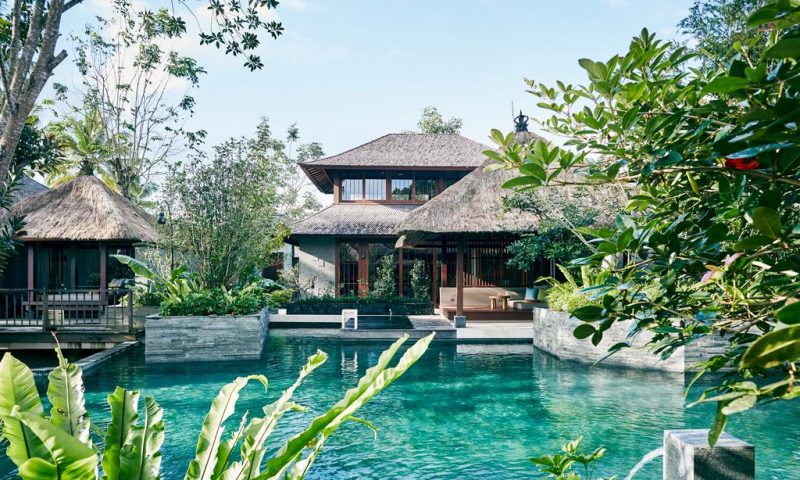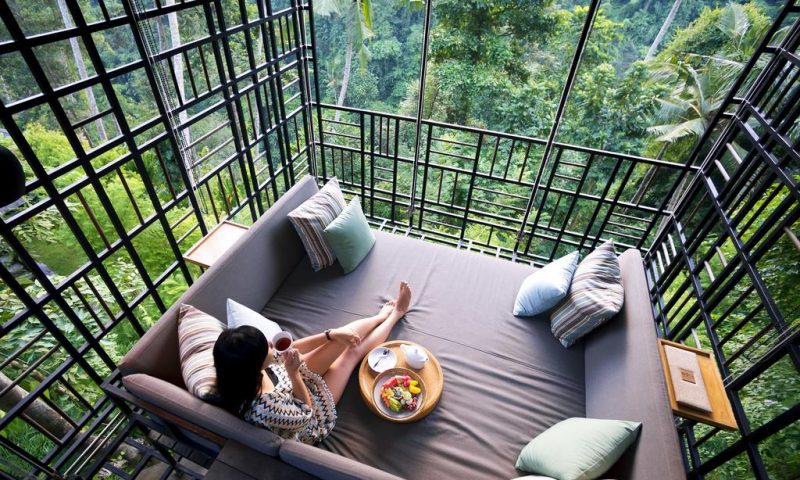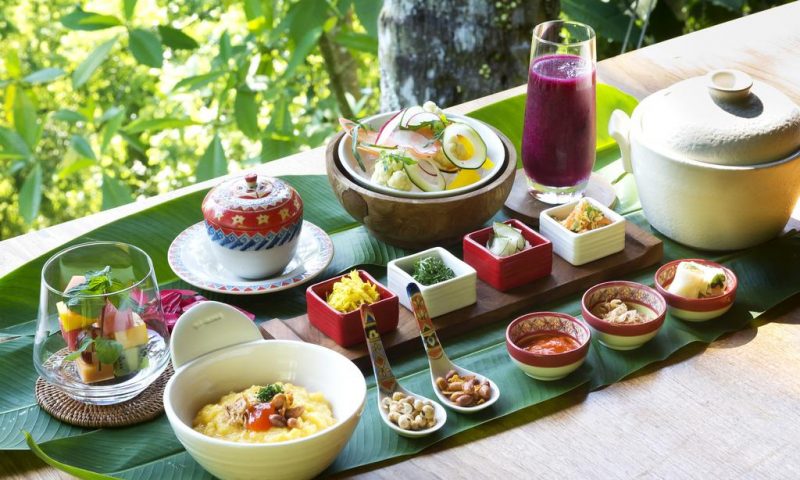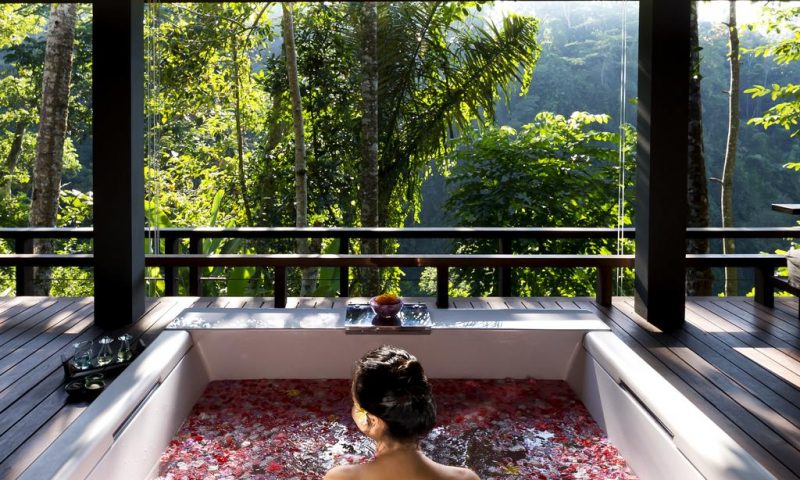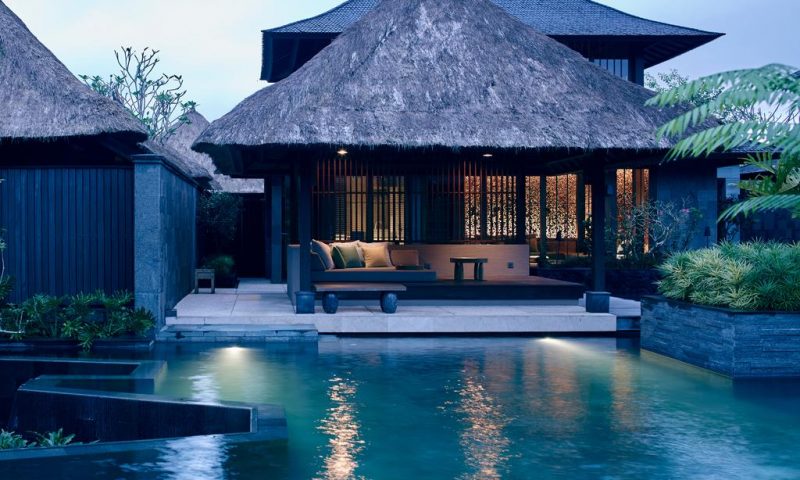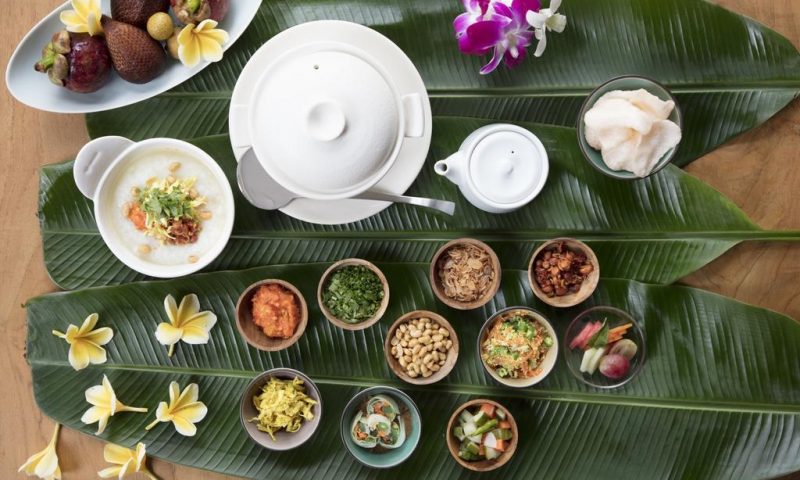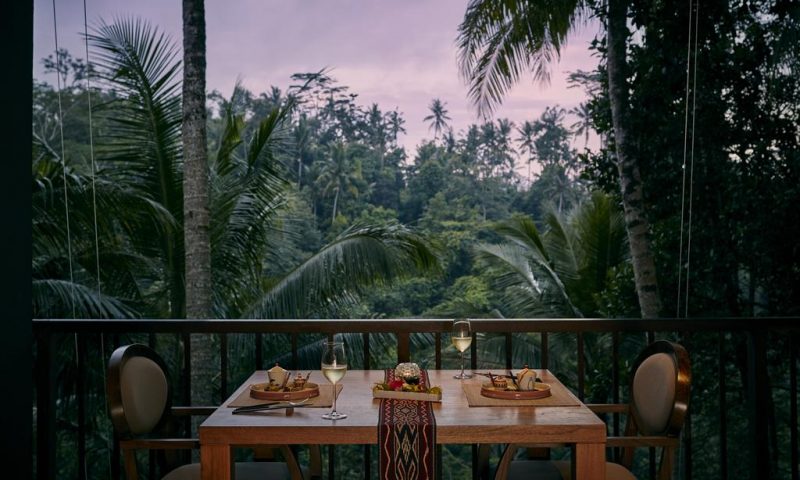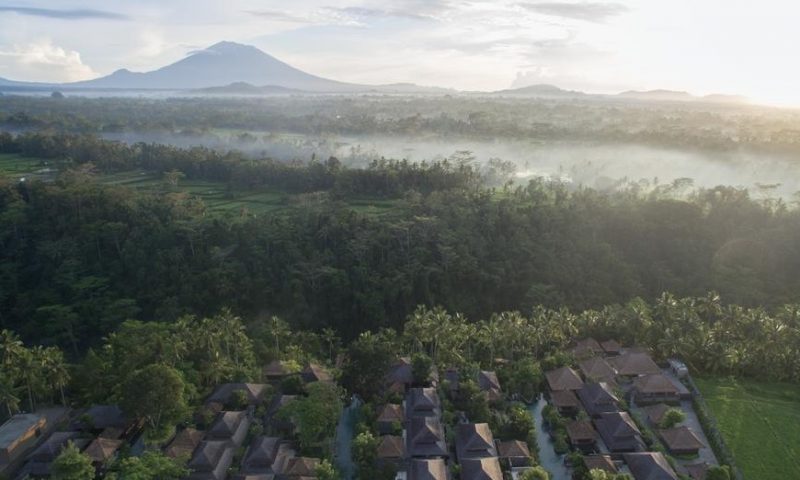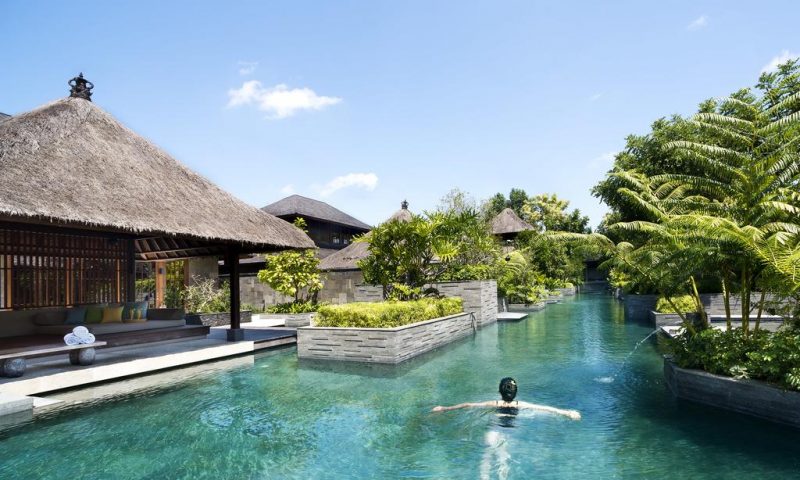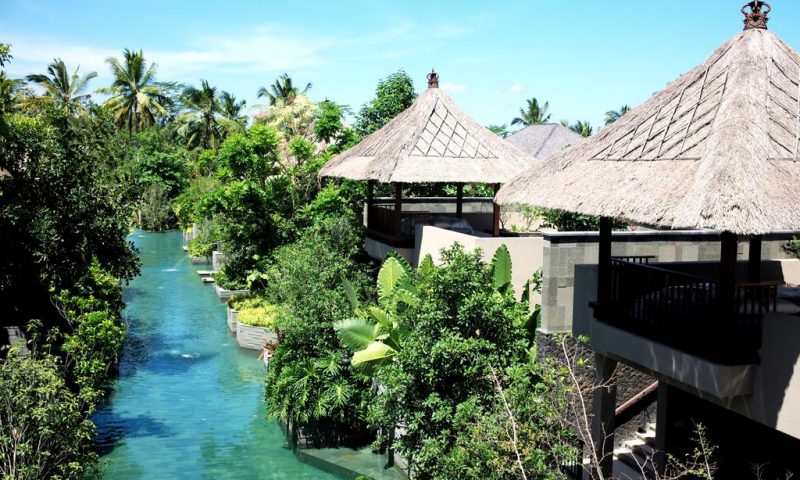Bali is home to numerous ancient palaces and water temples that create an atmosphere of elegant majesty. Their designs are rooted in Balinese Hinduism,
a spiritual philosophy that emphasizes balance between the human and the natural–even the supernatural.
It is this balance that defines the wondrous delights of HOSHINOYA Bali –a resort village nestled in a Balinese jungle that flourishes atop a hill, which drops off to a sacred river flowing below.
The Presence of a Sacred River
The god Indra is said to have created the famous spring of Tirta Empul when he thrust his sword into the earth and drew water from the ground. These holy waters flow into the Pakerisan River, nurturing the jungles of Ubud that grow along its banks.
Wherever you are in HOSHINOYA Bali, you feel the river all around you. Its booming roar echoes throughout the premises, while its waters turn into mists and rainclouds that constantly replenish the lush sheen of the resort’s trees and plants. Its omnipresence makes you feel as if the river itself is a god.
Land of the Gods
You take a deep breath, filling your body with air so pure, it feels as if it may have never been inhaled by another being. The Balinese have long lived by the teachings of Balinese Hinduism, a spiritual philosophy that combines Hinduism with animism.
In the spirit of this tradition, at HOSHINOYA Bali, flowers are offered to the gods every morning. In the evening, the sacred sounds of the gamelan ring through the premises, attuning you to the presence of the gods as you soak up the natural energy all around. Gradually, your body is immersed in both the natural and the supernatural.
A Design Unified by Water
One defining characteristic of a community is the sharing of water from the same source. You can see this in the subak, an irrigation system that has for more than 1,000 years nurtured a spirit of cooperation among the Balinese while sustaining the island’s renowned rice terraces.
The pristine waters that run through HOSHINOYA Bali come from subaks; they shape the very design of the resort. By sharing this water, you, too, become a part of the community, partaking in Ubud’s philosophy and culture.
The Pleasures of Poolside Living
You dip your foot in the cold pool, and a pleasant tingle runs up your body. Three canal-like pools connect the villas of this resort village, offering aquatic bliss to all those who enter their waters. You sink your head below the pool surface and close your eyes as if in prayer.
The pristine waters begin to slowly cleanse your body, lulling you into a comfortable stupor. As you lift your head out of the water, you see your neighbor across the pool and wave in greeting. The waters of Bali, it seems, are for both cleansing and for socializing.
A Very Memorable Repose
You climb into an elevated gazebo, one of many scattered around the premises. From here, jungles stretch in almost every direction, while the trees are so close you could reach out and pluck a coconut. A gratifying sense of relaxation overcomes you; before you notice, you have dozed off.
It is a deep sleep, the kind you have never experienced before. You feel as if you have melted away into the wind, as if you have become a part of the jungles that surround you. You wake up and leave your temporary abode, feeling more at peace than you have ever felt.
A Seamless Connection to Ubud’s Jungles
Ubud has long been an artistic center, where traditional art forms have evolved with the influence of visiting foreign artists. Villas in HOSHINOYA Bali feature walls decorated with wood-engraved pictures, each one telling a different story related to Ubud’s birds, flowers, and trees.
The stone walls of the poolside living areas also feature complex engravings with plant and animal motifs, creating an aesthetic connection between the villa interior and the majestic jungles that extend beyond the villa. You hear a gentle breeze passing through the villa; it is this seamless link to the outdoors that defines true Balinese relaxation.
Comforts Afforded
by Traditional Balinese Lifestyles
At HOSHINOYA Bali, traditionally Balinese villas dot a resort village located near precious bodies of water. Upon arrival, guests travel down a narrow path and through a tiny gate into their villas. There, they find a courtyard containing a gazebo with a roof made of alang-alang, a sacred grass.
Guests are invited to recline on the sofa in the shade of the gazebo and enjoy the gentle waterside winds that pass through. Just past the living area are the emerald green waters of the resort’s pools.
A semi-private section of the pool is set apart by a water garden, a subtle separation that evokes a stream running through the jungle. Brush past the vegetation, and guests will find themselves in a 70-meter pool that is available to them day and night.
Villa interiors are decorated with beautiful furniture and wall hangings that feature traditional wood carvings. Each carving tells a story related either to Ubud’s nature or its folklore, as depicted by master artisans.
Large windows can be opened to bring in soothing breezes. This design pays respect to the Balinese philosophy of balancing the human with the natural and the supernatural.
Jalak (Garden Pool Villa with Terrace)
Majestic river valley views
These single-floor villas overlook the jungle that carpets the Pakerisan River Valley. Each villa sports a wide, winding balcony, where guests can enjoy expansive views throughout the day, as well as the babbling river and chirping birds that grace a typical Ubud morning.
Ubud culture can also be found inside the villas, in the form of woodcarvings and other Balinese art. These villas are located nearest to the restaurant, spa, and other public areas, making them best suited for families with young children.
ARCHITECTURE
An Encounter with Balinese Culture
There is a strong sense of tradition and culture in Bali—nowhere more than in Ubud, where HOSHINOYA Bali is located. In Japan, only Kyoto matches the cultural devotion of this region.
Azuma—who has designed every HOSHINOYA resort to authentically incorporate the charms and cultures of its specific location—was presented with a difficult task. On the one hand, she was to design a resort that was distinctively Japanese—a recognizably HOSHINOYA experience.
On the other, this was to be the first overseas HOSHINOYA resort; it needed to make a statement about what the company could offer the wider world.
Initially, Azuma spent her time researching Balinese culture by visiting Hindu temples and traditional Balinese homes and villages, as well as by studying traditional craftsmanship at metal, stone, wood, and batik workshops throughout Indonesia.
Inspired by the people she met and discoveries she made, Azuma arrived at a design that was at once authentically Balinese, and also faithful to the HOSHINOYA aesthetic. The completed resort is one that meticulously balances Japanese spatial design with Balinese culture.
The HOSHINOYA Bali villas line three canal-like swimming pools. Each villa features a terrace that provides spaces—such as poolside lounges and gazebos with thatched alang-alang roofs—that are tailor-made for enjoying Bali’s temperate climate.
As a whole, the villas form a village-like formation that elegantly contours the pools—an design feature that can only be fully appreciated from the water.
Public areas offer contemporary comforts set against a classical Balinese backdrop; at the same time, they allow the adjacent sunken river valley’s refreshing breezes to flow through the space.
LANDSCAPE DESIGN
Creating Two River Valleys from One
HOSHINOYA Bali is located in eastern Ubud, on a flat tract of land that dips suddenly towards a river valley. It is a very typical type of Balinese geography, and Hasegawa used it to create two distinctive zones.
The villas are all located on the flat part of the premises, where they surround three long canal-like swimming pools.
The pools are dotted with carefully arranged water gardens that Hasegawa used to create private sections of pool that are immediately adjacent to each villa, as well as a canal-like public area in the center of each pool.
The gardens give the pools the appearance of naturally-occurring streams—a visual echo of the river valleys found in this part of Bali. Public spaces, which are all located at the edge of the valley, are similarly woven into the natural landscape.
Along the top of the valley, a boardwalk has been built along an ancient canal—a key feature of the traditional Balinese irrigation system known as a subak.
Guests first set foot on this boardwalk upon exiting the reception building, which is located in an inconspicuous part of the resort; they are immediately transported to a Balinese jungle.
A series of birdcage-like cafe gazebos hover above the boardwalk and look out onto the valley. Here, guests may relax in an environment that offers a full view of the surrounding majestic nature.
LIGHTING
Illumination Delivered Through Traditional Craft
Although Ubud’s nights are pitch black, Takeishi wanted to create a lighting scheme that would still allow guests the warm comfort provided by the bright, twinkling stars.
He decided to forgo direct lighting by wrapping light sources in batik cloth or placing them in containers crafted by Balinese artisans of iron, copper, wood, and stone. The light cast from these works creates deep, beautiful shadows, while the illumination is spread warmly throughout the space.
Perhaps most stunning of all is the subtle lighting embedded at the top and bottom of each villa’s wall carvings. This lighting scheme accentuates the fretwork of the carvings, in the process enhancing the depth and beauty of each piece.
Pendant lights and wall-bracketed lighting are used to create a sense of privacy on the balconies and terraces of each villa. The pool area, meanwhile, is illuminated in a way that makes it appear to be an extension of the living area.
Every bit of lighting was specifically designed to enhance the sense of wonder that one experiences when staying in the remote jungles of Ubud.
Reveling in the Joys of Balinese Cuisine
Bali is a treasure trove of ingredients and natural spices. Tuna, black tiger prawn, and other delicacies from the sea are prepared with chayote, leafy vegetables, and other local produce, and spiced with turmeric and a wide range of gingers.
In Indonesia, it is customary to order a large plate of food and share it with friends and family. Meals at HOSHINOYA Bali, however, are designed to offer the pleasures of traditional Balinese and Indonesian cuisine a little at a time.
Guests are served a 9-course meal that includes an appetizer, main dish, and dessert so that they may enjoy a variety of regional culinary delights.
Ingredients and spices bring out the best in each other, allowing guests to discover the joys of Balinese cuisine in a setting backdropped by majestic jungles.
Fine Dining Meets Traditional Craftsmanship
The mystical sounds of the gamelan ring through this spacious open air restaurant, where guests may enjoy their meals while gazing out at the nearby jungle. Dishware has been customized to suit the colors and textures of Balinese cuisine.
Amuse-bouches are served in die-cast dishes with complex batik motifs. Larger dishes are placed in serving baskets, featuring designs inspired by the baskets that Balinese Hindu disciples use to present their daily offerings to the gods.
In this way, guests are presented with a continuous parade of fine Balinese craftsmanship, which is also evident in the furniture, decor, and wood carvings that grace the restaurant.
Dinner
Guests are served multi-course meals made with the finest local ingredients, selected to stimulate the senses with their authentically Balinese smells and flavors.
The restaurant also has an à la carte menu. Over 50 traditional Indonesian and Japanese dishes are available for guests to enjoy over the course of their stay.
Air Gazebo Breakfast
In “Cafe Gazebo” where you can relax on comfortable sofas that have been designed to blend in with the jungle they overlook, we offer light breakfast in a picnic style. You can enjoy breakfast featuring the resort’s take on the traditional Balinese dish terang bulan.
Indonesian
Bubur–a traditional Indonesian congee–is served along with nine colorful condiments. The sunlight that pours into the restaurant at this hour is especially soft and relaxing.
Western
Bread and pastries, confitures, cheese omelettes, and salads are among the items served in this hearty breakfast. There are also fruit plates abundant with tropical flavors and aromas and other items prepared especially for Bali.
Japanese
Fried fish, accompanied by several side dishes, is served with rice and miso soup in this classic Japanese breakfast.
In-Room Dining
Guests who are checking in late or who prefer to eat light may choose from a variety of items, including Indonesian finger foods prepared with finesse.
Apéritif Restaurant and Bar
Belgian Executive Chef Nic Vanderbeeken takes culinary influences from the old Spice Islands and combines it with distinctly modern European flavours and cooking techniques.
The sophisticated, eight-course degustation menu presents an unrivalled culinary journey that brings together the flavours of modern gastronomy, lesser-known Indonesian ingredients, exquisite produce sourced globally, and the property’s own greenhouse harvest.
A Setting Fit for a Special Occasion
With its elevated cafe gazebos where one can feel as if they are occupying their very own space in the jungles of Ubud, and private villas with poolside living areas, HOSHINOYA Bali is the perfect place for celebrating a special occasion.
With a backdrop of lush vegetation and the singing of tropical birds, and a dedicated staff ready to meet your needs, we promise a memorable experience for host and guests alike.
Spa Therapies Guided by Nature and Technique
Balinese massage is an ancient art that started in the courts of the Javanese King. At HOSHINOYA Bali, veteran practitioners of this technique apply herbal medicine, rice flour, and other natural ingredients to revive the skin’s vitality, while easing muscular and spiritual tension and realigning the ki without applying too much pressure on the body.
Spa rooms are located halfway down the hill from the resort, so guests become more attuned to the sounds and energies of the jungle, as well as the Pakerisan River below–an environment more conducive to deep relaxation.
A yoga gazebo that overlooks the Pakerisan River Valley offers guests opportunities to relax twice a day. Morning sessions are designed for awakening; night sessions are for meditating in the moonlight.
BALINESE DANCE AND BEAUTY RITUAL
This is a wellness program involving traditional Balinese dance, food and spa treatments.
Our one-day wellness program begins with early morning yoga, then continues with Indonesian food, a Balinese dance experience, and a spa treatment which will foster an appreciation for traditional Balinese dance designed to bring out the beautiful, flexible body inside each guest.
Deep Waterside Relaxation
Three canal-like swimming pools cut across the resort’s premises. They are open all day and can be directly accessed from one’s guest villa, just past a private area demarcated by a carefully arranged water garden.
Located along the 70-meter length of each pool are lounges and gazebos where guests can sit back with a book or simply take a nap to bask in the tropical breezes that blow through.
In Bali, it is customary to bathe several times a day to stay comfortable in the island’s tropical heat; guests are invited to participate in this tradition for a truly relaxing waterside experience.
The Many Distinctive Beaches of Bali
Bali is surrounded by pristine beaches that offer a different atmosphere than that of Ubud. HOSHINOYA Bali provides transportation to and from these beaches. For snorkeling and diving, guests should visit Candidasa, a quiet area on the island’s east coast that offers respite from the bustle of central Bali.
For emerald green jungles, guests should head to Padang Bai; a walk up the coast will take them to a popular “hidden” beach, Blue Lagoon Beach.
For beachside cafes and restaurants, guests are encouraged to explore Sanur, a resort area in the south that is popular with tourists from all over the world. Each beach area offers something different for visitors to enjoy.
Candidasa
This quiet area was once a small fishing village, and it offers respite from the bustle of central Bali. Its translucent waters are home to colorful fish and coral, making the area perfect for diving and snorkeling. This is the place to go for a visit to Bali’s underwater paradise.
Padang Bai
The beaches of this area lie just beyond a vast expanse of lush, emerald green jungle. A walk up the coast will take guests to Blue Lagoon Beach–a popular “hidden” beach. It is the perfect destination for beach-goers who simply wish to spread out their blankets and relax.
Sanur
Sanur is located in a traditional Bali resort area. The gentle terrain and easy pace of life here has made this beach a popular destination for people from around the world. Exploring the many beachside cafes, restaurants, and boutiques in this area is highly recommended.
BATIK SAYA
Batik is a batik fabric cloth that covers the pattern with wax to makes it uncolored, then dyes the whole. In HOSHINOYA Bali, you can make a batik using our special patterns. Make only one batik in the world while changing the combination of patterns and colors.
UBUD DANCE TOUR
Dancers dressed in vibrantly colorful native outfits move enchantingly to the soulful rhythms of the gamelan in this traditional Balinese art.
ULUWATU TEMPLE TOUR
Guests are taken to Uluwatu Temple, located at the top of a tall cliff on the south of the island, where they are treated to a kecak dance performance as a beautiful sunset takes place in the background.
A modern Italian meal is then served for dinner. Because the location is near the airport, guests whose return flights are at night are recommended to save this special treat for their final day.
BALINESE DANCE
Local children perform gamelan, an ensemble music that is traditionally played in Bali, as well as Balinese dance.
BALINESE CRAFTS WORKSHOP
The Balinese are a deeply spiritual people who consider prayer to be an important part of their lives. In these rituals, they make offerings known as canang sari and kwangen. Guests at HOSHINOYA Bali are invited to learn how to make these items under the guidance of the resort’s local staff.
Creating these delicate arrangements of flowers and leaves requires a high level of patience and care; through this activity, participants may achieve the same spiritual calmness as the local worshippers do through their rituals.
INDONESIAN TEA TIME
Spices and herbs play a major role in Indonesian life. Traditional Indonesian healthy drinks is made with ginger or turmeric. “Jamu” and “Wedang”, herbal medicine prepared from a variety of natural ingredients based on ancient recipes. Guests of HOSHINOYA Bali are given the opportunity to experience them.
YOGA
Guests are invited to purify their minds and bodies through yoga and meditation while gazing at the Pakerisan River Valley below and surrounded by vast nature.
It holds 3 sessions in every day. Sun Salutation Yoga is designed to wake the body, while Moon Salutation Yoga is intended to soothe and relax. In the day time, Aquatic Yoga is held in the pool and guests could stretch efficiently.
